Reaching Our Visions: Negros Island is Now the Philippines' Solar Energy Capital After Years of Renewable Energy Campaign
The Philippines is a relatively small country but our ever-growing population continues to drive our high demand of energy. Ever since I was 14, my friends and I have always involved ourselves in environmental advocacy and working with non-profits. My time with Solar Generation Youth Negros, the youth arm of Greenpeace's energy and climate advocacy in the Philippines, was one of the longest I have spent working in a non-government organization and has shaped my mentality towards society, the government, and individual people.
What is Solar Generation Youth Negros?
Also often referred to as Solargen for short, Solar Generation Youth Negros is simply a bunch of kids who spent their extra time outside of school to talk about renewable energy to other youth, institutions, and even to a sheer random public. Click here to view an old blog by a friend named Chuck from Greenpeace where he talks about Solargen volunteers campaigning about energy efficiency and renewable energy during the famous and lively Masskara festivity. I personally spent my time in Solargen giving lectures in schools, talking before a crowd, manning photo exhibits, lobbying with politicians, and the most exciting part, setting up off-grid solar photovoltaic kits as replicas of industry-scale solar energy generation.
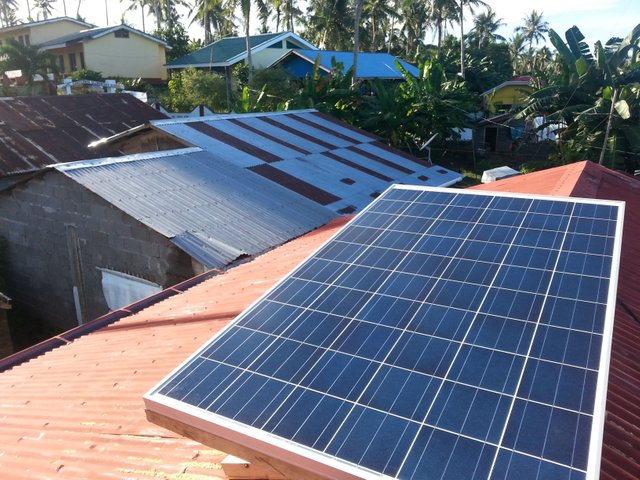
An off-grid photovoltaic system that I have installed on the roof of a community health center in Hernani, Eastern Samar through a post-Yolanda development project by ACF International (photo owned by author)
What is Solar Energy?
Solar energy is simply energy coming from our big bright sun. This massive heavenly body contains a large amount of energy that even the slightest rays emitted to earth serve enormous purpose in our everyday lives. We need solar radiation to live on earth. It is what keeps this planet warm enough to be livable. While it keeps us warm, we also use this energy in many other ways such as plants using them for photosynthesis, us needing to dry our clothes, farmers who sun-dry their produce, and many other artisanal and natural ways. But there's just too much solar energy around us, that it's almost impossible to consume. By the laws of physics and electricity, this energy is very much available for a bit of electrical tweak to be turned into useful electrical energy for our homes.
Solar energy has two components: the heat and the light. Heat energy can be converted into electricity using thermoelectric generators. Light energy can be converted through photovoltaics systems or what we commonly refer to as solar panels. I will be talking about photovoltaics and solar panels in this post as they're the ones I am most experienced with. Solar panels are simply crystal sheets or bits of crystal, typically silicon, shaped into a flat sturdy piece. When the sun's rays hit the surface of the panels, the electrons in the silica crystal are energized causing them to flow. If this starts ringing a bell from your high school physics, a flow of electrons means you've created current! At this stage, current produced is DC (direct current) at a low voltage.
Because the intensity of the heat of the sun changes almost instantaneously, it also means that our direct current continues to fluctuate with it. On really bright days we can get around 16 volts while on cloudy days it could drop to 5 volts. That is why we connect wires to our solar panels and route the current to a controller. A controller is an electronic device that maintains the voltage level of your system so that it produces a constant output.
A solar-powered facility called RE-Charge in Tacloban City (photo owned by author)
Now that we have constant voltage coming out of our photovoltaic system, renewable energy conspiracists would come to us and say "what do we do at night when there's no sun?" That's almost a rhetorical question but believe me, I've had people come up to me and ask that question like dead seriously. The answer is simply that we store the energy coming from the controller to a battery bank. Batteries are rated in AH or ampere-hours where ampere is the unit for current and hours means multiplying that current to the amount of time it can supply power to a load. Higher AH basically means a bigger battery capacity but also means it will take a longer time to fully charge the bank. At this point I can say that planning and designing a photovoltaic set up is crucial.
So are we now ready to use solar energy? Not quite yet. The grid electricity we have in our homes is in the form of alternating current - 220 volts AC in the Philippines and 110 volts AC in other countries. Our appliances are all designed to receive alternating current. However, the truth about most of our electrical circuits is that they don't need 220 volts, most of them need only maybe about 10 volts or less. Take your cellphone charger for example. When you connect your phone to a USB port on a computer, it charges your phone using only about 3.7 volts direct current. But when you connect your phone to an electrical outlet, you will need the "power plug" which receives 220 volts alternating current and converts that into the 3.7 volts direct current that your phone needs. That's a lot of energy conversion happening in such a small place!
If we go back to our solar photovoltaic system, I can peg a typical controller to about 15 volts direct current. So instead of going through all the hassle of converting to 220 volts alternating current, we can just connect it with a voltage clipper so we can get the 3.7 volts that we need. More efficient and lesser loss of energy!
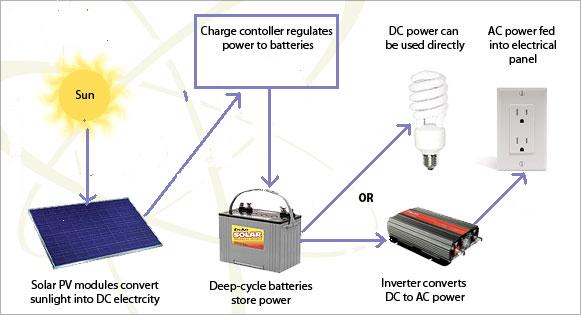
The basic diagram of a photovoltaic system (click to view image source)
My idea of a perfect world would be where engineers design efficient circuitry in our appliances that need only very low voltage so we can simply generate electricity directly from the sun and use it to power those appliances. Sadly, we're not in that world yet. If we have more visionary engineers, maybe we will get there one day.
So snapping back to reality and facing the truth that our appliances today need 220 volts of alternating current, we need a power inverter. A power inverter is an electronic device that converts direct current to alternating current. It means that now, we will increase the intensity of the current and make it compatible to our appliances. Obviously at this point, we can now use our photovoltaic system to power up our homes.
Why I like solar power
I definitely love solar power and in fact, I spent fourteen months working with a non-profit called RE-Charge Tacloban to power up a facility using photovoltaics and to teach members of last mile communities how to use a portable solar kit as a disaster preparedness tool. Solar panels harvest the potential coming from our greatest source of energy, the sun. While many other forms of energy generation such as wind and hydro use the concept of generators (rotating turbines to create electromagnetic field), solar energy doesn't employ any noticeably moving parts making it safe and easier to maintain. Solar energy generation produces little to no greenhouse gases compared to it's fossil fuel counterpart which is coal.
Solar energy is the most suited form of energy generation if we want a world that can mitigate climate change and global warming.
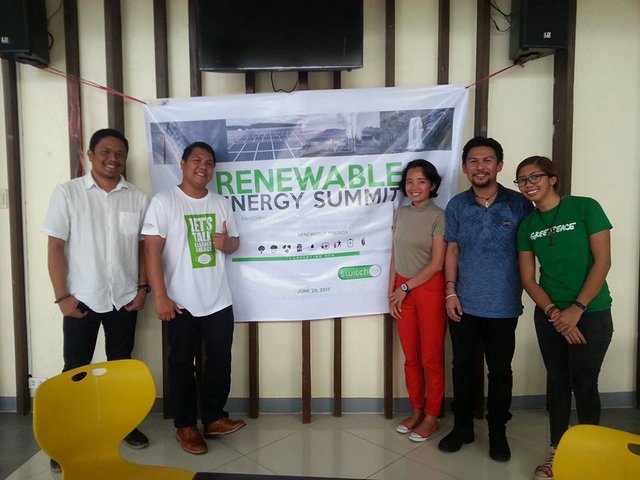
Solar Generation Youth all grown up now and having a reunion at a recent Renewable Energy Summit (photo owned by author)
Visions Do Come True
Indeed! Visions do come true! For more than a decade now, I have been advocating renewable energy. It is challenging to be an environmental activist as people will doubt and question you whenever they can and you will always have to stand firm with your principles.
But what I am most proud of is that today, as I am writing this post, my very own home island of Negros has stand with us in our fight against climate change and has gone on to be the Renewable Energy Capital of the Philippines. According to the National Grid Corporation of the Philippines, there are at least six companies that have put up one or two solar farms both in the Oriental and Occidental part of the island.
Here's where you can find them:
Bais City, Negros Oriental
Monte Solar Energy, Inc. (Montesol)
A foot note about this solar farm is that it is right next to URSUMCO or the Universal Robina Sugar Milling Corporation. It is one of the few sugar mills still operating in the island of Negros, also known as the Sugar Capital of the Philippines as we are most known for our sugarcane produce. This area here shown in the picture is very close to my heart as I have worked at URSUMCO for two months as an intern and I sure fell in love with beautiful Bais City.
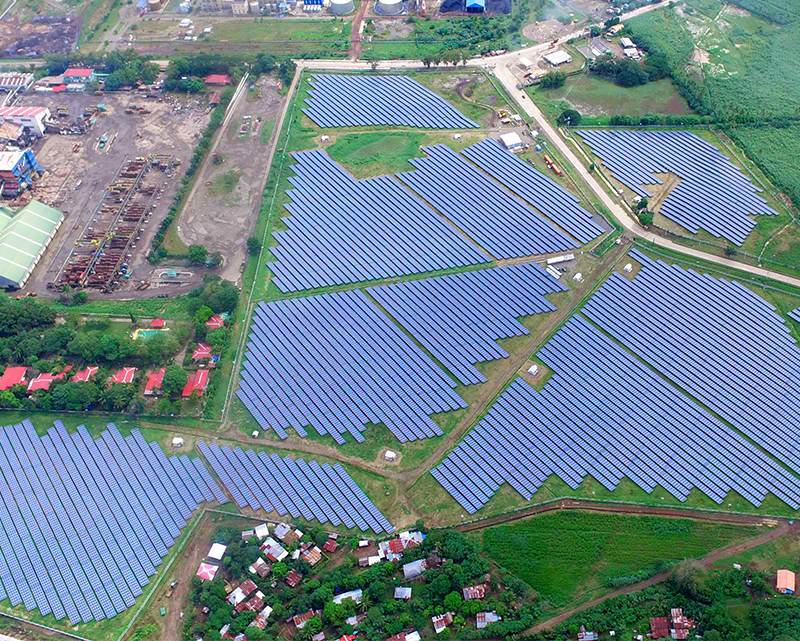
Cadiz City, Negros Occidental
Helios Solar Energy Corporation
Helios Solar Energy Corporation is the largest solar farm in Southeast Asia generating up to 132 megawatts of power.
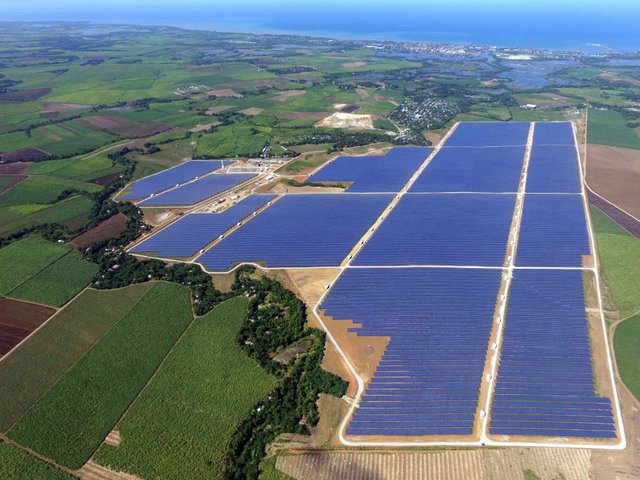
Aerial view of the largest solar farm in Southeast Asia (click to view image source)
San Carlos City, Negros Occidental
San Carlos Sun Power (SaCaSun)
SaCaSun is the second solar farm in San Carlos City that supplies up to 59 megawatts of electricity. This solar project is a subsidiary of Aboitiz Power.

SaCaSun solar farm in San Carlos City (click to view image source)
San Carlos City, Negros Occidental
San Carlos Solar Energy Inc. (SaCaSol)
SaCaSol is the first ever utility scale solar farm in the Philippines that produces a gross of 45 megawatts of electricity.
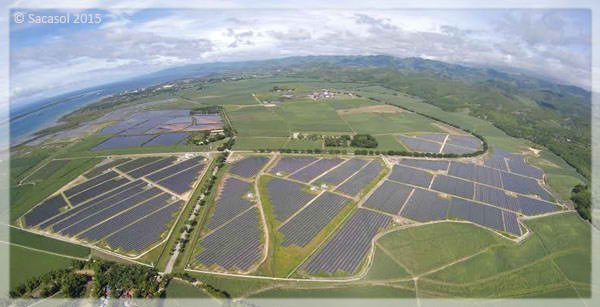
The country's first industry scale solar farm (click to view image source)
La Carlota City, Negros Occidental
Negros Island Solar Power, Inc. (Islasol I and II)
Negros Island Solar Power, Inc has two sites called Islasol I and Islasol II and were formerly known as SaCaSol II and SaCaSol III, respectively. Islasol 1 produces up to 32 megawatts and Islasol II produces up to 48 megawatts power and are both located in the city of La Carlota.
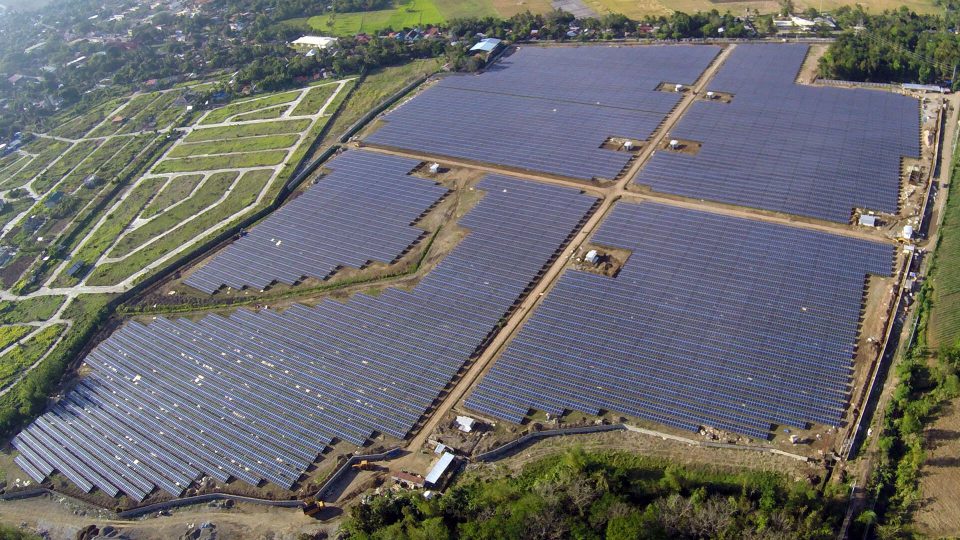
Islasol I, formerly known as SaCaSol II (click to view image source)
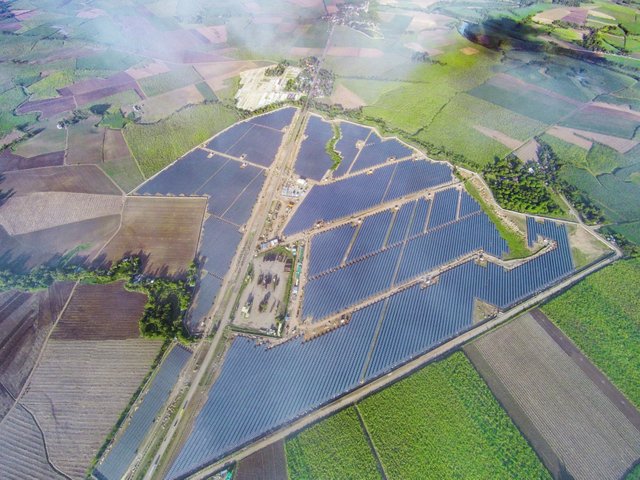
Islasol II, formerly known as SaCaSol III (click to view image source)
Silay City, Negros Occidental
Silay Solar Power, Inc.
At a humble 25 megawatts peak, Silay Solar Power, Inc. is the solar farm closest to Negros Occidental's capital city of Bacolod. Silay is well-known for the international airport and preserved heritage houses and museums, and has now made its name in the renewable energy scene.
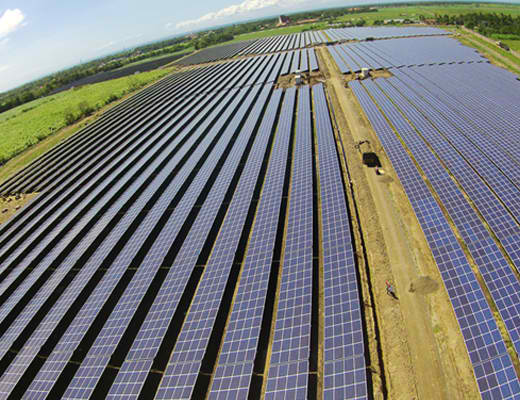
A solar farm in the city (click to view image source)
We were talking, now they're walking
Talking about climate change and renewable energy to an individual or a stadium with a big crowd has been the life I've known for years on end. I hold steadfastly to my principles that there is only one earth for us to live in and it is impossible to damage the climate irreversibly without posing a threat to our own existence. The fight against fossil fuels and global warming is a lifelong battle and it continues to this very day. But we take little steps and put them altogether to make an impact. Negros may be a small island but it has become the home of the tiny flame that was fueled by our love for mother nature and now we watch the fire it has grown into, a fire that provides light in this lifelong advocacy.
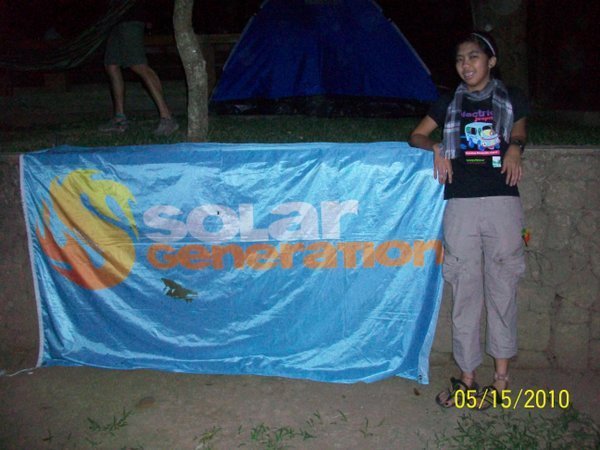
Me at a Renewable Energy Camp in 2010 (photo owned by the author)
Thank you for your time!
Sunny regards,
@xaydtrips


It is in the islands that solar energy has the best rentability, thank you for this news.
That should answer some questions. Thank you sir! @solarcoach
here in South Africa we have managed to scrap our governments plans to build nuclear power-plants, hopefully forever.
we have an abundance of wind and sunshine and we will become a solar-power house in the future. We already produce roughly 1GWH of solar-power with our government forced to invest in renewable energy sources that figure is bound to increase.
our very lives depend on harnessing and understanding our sun. This technology has been suppressed for to long!
Wow! This is amazing! It's great that we have like this in our country. Nakakaproud. 👍👍
I know right? It's very fitting for a tropical country to have solar farms like these :D
Thank you for reading @ayingroxie!
Congratulations @xaydtrips! Woooh! Aside from your environmental advocacies and your drive towards renewable energy, which are both commendable, you rock on this post! The research done is topnotch. Congrats on your two first in 1 week! First curie and first steemstem! More to go! Keep it up.
@ybanezkim26 this is all so overwhelming! I know I always say this but I owe all of this to you! I'm really glad you introduced me to steemit because now I have a place to pour out everything my noisy brain wants to say. 😊😀
This is exactly why I joined steemit. To have an outlet of my musings which kept me from having a good night's sleep. Hahaha
My respect for you grows with every post, @xaydtrips. I have to ask, who (or what) inspired you at 14?
Thank you @thegaillery for your kind comments every time!
It's a funny story that if I gather enough courage will probably be writing about eventually. I listened to a lot of 80s punk and punk rock back then and they said that to be a "real punk rocker" you have to rebel against the government.
Because I wanted to be a "real punk rocker" I rebelled against the government for putting up too many coal-fired power plants because they were killing the climate. Seriously, I was just a kid wanting to be cool but different. I never imagined that from there I'd be advocating renewable energy for the rest of my life. :D